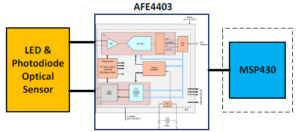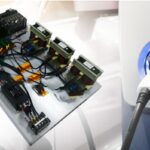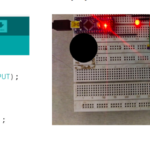I frequently design new electronics systems. Sometimes these are variations of something I have done before and at other times they are completely new. If you are new to a particular product area and there is something similar in the marketplace then it is always a good idea to have a look at how other people have solved the problem before you start. Even if you choose a different solution to the problem, you will at least be better informed. One source of information, which I must admit I don’t often use, is to look at the websites of IC manufacturers under “solutions” or “applications”. It can take a bit of searching around because the words and terminology used may not match the ones you are using, but you may find some useful ideas and even reference designs to get you started.
For example, if you search for “heart monitor” on Texas Instruments‘ website in their “reference designs library” you will find a complete design for a “Multi-Parameter Bio-Signal Monitor Reference Design For Personal Monitoring“. It includes Electrocardiogram (ECG), Galvanic Skin Response (GSR), and skin temperature measurement. It even includes an Android App and near field communications (NFC) as well as schematics, PCB layouts and firmware. It is unlikely to be exactly the design you are looking for but should give you an idea of suitable devices for different parts of the design if it has similarities with what you are trying to achieve.

What if your application is totally new and different so there is no obvious comparative product to help you get started? In that case you need to start a system design from scratch. Start by listing the “inputs” and “outputs” to the system. An “input” might be a sensor or human interface, or Wifi, Internet or Bluetooth connection. “Outputs” could be visual, a motor movement, or communicating data. In between your inputs and outputs there will be some “processing”.
This processing may not actually be digital or require a microcontroller depending on the relationship between the inputs and outputs. An analog system which produces outputs based on analog inputs can be made which is totally analog. For example, a passive infra-red detector such as those used for intruder alarms can process the signal from the sensor and produce an alarm output without resorting to digital circuitry. However, it is uncommon to find products now without a microcontroller in them, particularly because communications is a significant feature of new products. Texas Instruments’ motion detector solution has a microcontroller, but then it also has some communications.

The extent of the processing required is something which can be tricky to estimate. If you underestimate the processing required it can be difficult to increase the processing power later. If you overestimate then you could be increasing the cost, size, and power consumption unnecessarily. There is no escaping the benefit of writing a decent specification for what you are trying to achieve, including a description of the data processing requirement. The benefit of a bigger, faster processor is speed. If you have a large amount of data to process then even a slow, 8-bit processor will manage it – eventually. But the rate at which you acquire data is likely to be determined by the application and while in some applications you can wait a few seconds for the data to be processed, in a lot of cases the data processing requirement is continuous and needs to keep up with the data acquisition rate.
There is a trend to minimize analog circuitry and use digital processing power instead. I have seen products which digitize an analog signal with minimal signal conditioning and then use digital filtering with a DSP (digital signal processor) to process the data. While it is a compact solution, it can result in a $25 DSP in a 361 ball grid array and associated PCB and assembly costs.
Analog signal processing chips are becoming more complex and targeted at specific applications, often with digital outputs. If your application is covered by such chips, such as energy metering or heart monitors, then it can greatly simplify your design. An example would be the Texas Instruments “Miniaturized Optical Heart Rate Reference Design” which simply uses two chips – a microcontroller and the AFE4403 which is an “Integrated Analog Front-End for Heart Rate Monitors and Low-Cost Pulse Oximeters” and has a digital output.

However, if your application is not covered by standard chips you will need to design your own signal processing chain.
I find some research can be invaluable when approaching a new design. This is particularly true of IC design where a search of the IEEE Journal of Solid-State Circuits can give a number of approaches to solving a particular design problem. Whether you manage to find some help in your system design from existing designs or not, there are a number of key criteria to consider in your system specification such as cost, size, signal processing, inputs, outputs, power source, environmental factors, approvals, standards required and the human interface.
Assuming your company doesn’t have specific procedures for you to follow, the FDA (Food and Drug Administration) “Good Manufacturing Practice” (GMP) rules have guidelines covering “Design Controls” (CFR Title 21 section 820.30), which is useful as a checklist of the requirements for a design. While it is intended for medical devices, the requirements of design planning, inputs & outputs definition, review, verification and validation etc are applicable to any product. Other sections cover aspects more related to manufacturing, but are still worthwhile looking at, such as Documentation Controls.
While the GMP rules are very general requirements rather than specific “rules”, I think they do give a useful checklist of things to consider when approaching a new design. I often see badly specified products which end up causing modifications and rework later on, and documentation which is not kept up to date so anyone referring to it doesn’t actually have an accurate picture of the latest product specification, which is frustrating.
Either in the design specification or proposed implementation document you will probably need to do some calculations to ensure your design is actually feasible. Those calculations could include cost, size and battery life as well as whether the signal processing solution is possible. For example, is there enough signal to noise ratio for the system to work with the desired bandwidth and data rate? Time spent early on in a project can save wasted time and money later if potential problems are spotted early by adopting a thorough specification stage.







Leave a Reply
You must be logged in to post a comment.